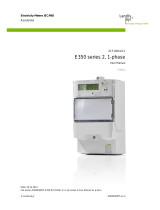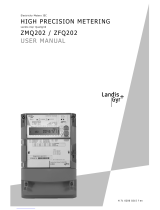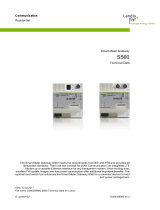
Operating and Installation
Instructions
Ultrasonic Flow Meter
ULTRAHEAT®T150 (2WR7…)
17.11.2021
Translation
T150 (2WR7…)
Landis+Gyr GmbH Subject to change without prior notice 17.11.2021 1
1. General
1.1 Use
The flow meter is used as a flow meter for calculators for
heating or cooling consumption measurement in systems with
water.
The flow meter consists of a metal measuring part and an
associated electronic unit. These two components are affixed
with each other by cable.
1.2 General Notes
The flow meter left the factory in a faultless condition where
safety is concerned. The manufacturer will provide additional
technical support on request. Calibration relevant security seal
on the flow meter must not be damaged or removed. Otherwise
the guarantee and calibration validity of the flow meter will
lapse.
• Keep the packaging so that you can transport the flow meter
in its original packaging following expiry of the calibration
validity.
• Lay all cables at a minimum distance of 500 mm to high
voltage and high frequency cables.
• A relative humidity of < 93 % at 25 °C is permissible (without
condensation).
• Avoid cavitation in the whole system due to overpressure
i.e. at least 1 bar at qp and approx. 3 bar at qs (applies for
approx. 80 °C).
2. Safety Information
The flow meter may only be used in building service
engineering systems and only for the applications
described.
The local regulations (installation etc.) must be
adhered to.
Adhere to the operating conditions according to the
dial plate during use. Non-adherence can cause
hazards and the guarantee will lapse.
The flow meter is only suitable for circulating water in
heating systems.
The flow meter is not suitable for drinking water.
Adhere to the AGFW requirements regarding
circulating water (FW510).
Do not lift the flow meter by the electronic unit.
Be aware of sharp points on the thread, flange and
measuring tube.
Only personnel, trained in the installation and
operation of meters in heating and cooling systems,
may install and remove the flow meter.
Only install or remove the flow meter when the pipes
are pressure-less.
After installing the flow meter, check the leak-tightness
of the system.
Guarantee and calibration validity will lapse if the
calibration relevant security seals are broken.
Only clean the flow meter from outside with a soft,
lightly wetted cloth. Do not use any spirit or cleaning
solvent.
As far as disposal is concerned, the flow meter is a
waste electronic appliance in the sense of European
Directive 2012/19/EU (WEEE) and it must not be
disposed of as domestic waste. The relevant national,
legal regulations must be observed as the appliance
must be disposed of via the channels provided for this
purpose. The local and currently valid legislation must
be observed.
The meter contains lithium batteries. Do not dispose of
the meter and the batteries with domestic waste.
Observe the local stipulations and laws on disposal.
You can return the lithium batteries to the
manufacturer for appropriate disposal following use.
When shipping please observes legal regulations, in
particular, those governing the labelling and packaging
of hazardous goods.
Do not open the batteries. Do not bring batteries into
contact with water or expose to temperatures above
80 °C.
The flow meter does not have any lightning protection.
Ensure lightning protection via the in-house
installation.
3. Installation
Proceed as follows to install the flow meter:
• Observe the dimensions of the flow meter and check
whether there is sufficient space available.
• Rinse the system thoroughly before installing the flow meter.
• Fit the flow meter vertically or horizontally between two slide
valves so that the arrow on the housing and the flow
direction match. Also observe the installation situations and
the following examples of installation (see figure 2 and
figure 3).
• Seal the fittings to protect against manipulation.
• Loosen the elastic band or the cable tie, provided for the
transport, from the volume measurement unit. In operation,
the control cable should not depend directly on the volume
measurement unit.
• If you install the flow meter for cold metering, follow the
appropriate notes.
Recommendation: If you are installing more flow meters in one
unit, make sure that all the flow meters operate under the same
mounting conditions.
Installation Notes
Note: When installing the flow meter the locally
applicable installation regulation for flow meters must
be observed.
Inlet or outlet sections are not necessary. If you install the flow
meter in the common return of two circuits, determine a place of
installation with a minimum distance of 10 × DN from the T-
piece. This distance ensures a good thorough mixing of the
different water temperatures.













